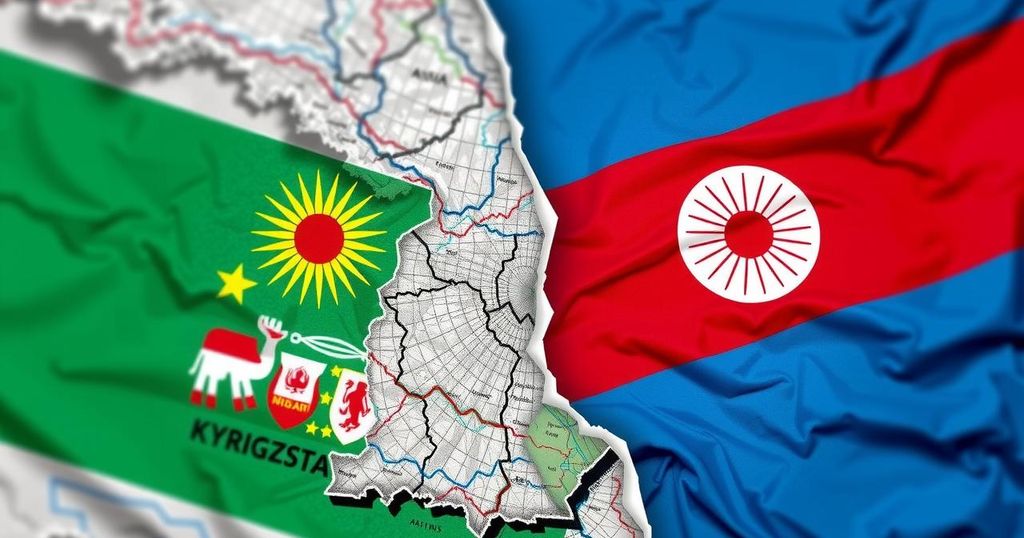Kyrgyzstan and Tajikistan announced a border demarcation deal on the last disputed frontier, potentially ending decades of conflict over territorial boundaries and access to water resources. This agreement comes after a deadly border clash in 2022, with significant geopolitical implications as Russia’s influence wanes in Central Asia. The deal signifies an improvement in bilateral relations and sets the stage for future cooperation between the two nations.
On Wednesday, Kyrgyzstan and Tajikistan reached a significant agreement regarding the demarcation of their long-disputed border, officially resolving the final contested frontier in Central Asia. This landmark deal may put an end to decades of territorial tensions that have resulted in sporadic violent clashes over access to vital resources. The border, stretching 970 kilometers, traverses some of the world’s most rugged mountainous terrain. The agreement, finalized between the heads of the respective secret services, follows a devastating border conflict in September 2022 that claimed approximately 100 lives.
Both governments announced the completion of the border drawing, following a meeting in the Kyrgyz city of Batken, where images of Kyrgyz security chief Kamchybek Tashiev and Tajik counterpart Saimumin Yatimov shaking hands were shared publicly. Officials from both nations have been directed to commence preparation of demarcation documents, reflecting a positive atmosphere of friendship and cooperation.
The origins of the border dispute can be traced back to Soviet administrative divisions, which lacked clarity and have led to ongoing conflict since the Soviet Union’s dissolution in 1991. Water access has been a particularly contentious issue, critical to the region’s agriculture and drinking supply in light of climate vulnerabilities. Recent years have seen a thawing of relationships among Central Asian countries, with high-level discussions taking place, signifying potential for collaborative resolution.
The situation escalated dramatically during the autumn of 2022, marking the worst fighting in decades, which resulted in significant displacement among local populations. The geopolitical landscape is further complicated by the decreased influence of Russia, traditionally a mediator in Central Asian disputes, as it grapples with the repercussions of its ongoing military actions in Ukraine. Countries such as China, Turkey, and the European Union are increasingly vying for influence in the region left vulnerable by Russia’s current preoccupations.
Negotiations were hindered by the unavailability of Soviet-era maps that could clarify border definitions. Kyrgyz Security Council Secretary Marat Imankulov voiced the challenge, stating, “Russia is the legal successor of the Soviet Union, there are archive documents and maps in Moscow.” Despite the complexities, the final agreement indicates a pivotal opportunity for both nations to reinforce their sovereignty and stability. The peaceful resolution of this territorial dispute not only brings closure to historical grievances but also sets a precedent for further diplomatic engagements among Central Asian states.
The ongoing tension between Kyrgyzstan and Tajikistan regarding their border can be traced back to the dismantlement of the Soviet Union in 1991, during which unclear administrative boundaries were drawn between the two nations. Over the subsequent decades, this ambiguity has manifested in intermittent conflicts, largely driven by competition over vital water resources, a critical issue in Central Asia, particularly as climate change exacerbates the scarcity of drinking water. The border spans 970 kilometers and features significant mountainous terrain, complicating settlement efforts. Recent escalating violence, particularly in 2021 and 2022, highlighted the urgent need for resolution, prompting high-level discussions and ultimately leading to the landmark agreement.
The successful resolution of the Kyrgyz-Tajik border dispute marks a significant turning point for both nations, reflecting a concerted effort to foster regional cooperation and stability. The agreement not only addresses historical grievances stemming from Soviet administrative practices but also represents a critical step towards securing access to essential resources amid pressing climate concerns. As Central Asian countries continue to navigate their evolving relationships, this milestone underscores the importance of diplomatic dialogue and negotiation in resolving long-standing conflicts.
Original Source: 24newshd.tv






